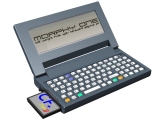![[LWN Logo]](/images/lc.png)
![[Timeline]](/images/Feature.png)
![[LWN Logo]](/images/lc.png) |
|
![[Timeline]](/images/Feature.png) |
|
Weekly Edition Daily updates Events Calendar Book reviews Penguin Gallery |
Beyond free software in Japan
Do these reasons apply only for software? Here are a couple of projects which stretch the open source model beyond the software world. The Open Hardware Palmtop Computing Association "Morphy One" is an open source
hardware development project in Japan, by OHPA (Open Hardware
Palmtop computing Association) Palmtop PC user group, lead by its main
designer R&D, Toyozou.
"Morphy One" is an open source
hardware development project in Japan, by OHPA (Open Hardware
Palmtop computing Association) Palmtop PC user group, lead by its main
designer R&D, Toyozou.
"Morphy One" is claimed to be the first IBM PC/AT compatible-
architecture-based palmtop PC produced only by users. ("Morphy One"
itself does not include software.) The project aims to put out all
the data on its development process and specifications under GPL.
The project's start was triggered off when HP discontinued the production of HP 200LX palmtops. Many of the currently active users of HP 200LX who don't want to let it just fade away, are now taking part in this project. They say that even if users have needs, when they are a minority, they can expect no supply from commercial vendors. But now that it is not impossible to design and produce computers by themselves, they gathered together and decided to make one on their own. Interestingly, Morphy One is not HP200LX-compatible. The choice is based on the idea that since they start a brand new project, they should think about the kind of computers they really want from scratch and have their pure needs reflected in their design.
Details of Mophy One's specification and their interpretation of GPL
(applied to hardware) are available in their press
release in English (released on their project launch). Even if
you are not satisfied with the specification, they say, you don't have
to give it all up, you can make one on your own based on the disclosed
design data of Morphy One, since it is open source!
Prototyping and quantity production will be done by Morphy Planning & Co., Ltd., a joint-stock company invested by 106 users. They plan to disclose all the processes such as the process of working out the production cost and the volume price. Though Morphy Planning & Co., Ltd. is planning to sell hardware only in Japan, they claim, of course, that anyone can produce Morphy One based products locally, freely and for free, under GPL. That means local vendors can become Morphy One distributors to localize, package, and distribute Morphy One, to make profit to pay off production cost and distribution cost (as long as they don't restrict other people's rights). The project is now working towards Morphy 1.0. (Current "interim work version" is Morphy 0.2.2.) Toyozou says, in an interview with Wired News Japan (in Japanese), that he even hopes to create an open source CPU and put it on Morphy One someday. References:
The Open Source Toys ProjectOpen Source Toys Project(in Japanese), lead by members of LLUG (Ladies' Linux Users Group (in Japan)) including Mariko Katagiri and Tomoko Yoshida, started in the spring of 1999 when some of them confessed they wanted cuddly penguins, too.They have released paper patterns (they dub this: "source code") and recipes ("documents") for four toys by now, and two of them have been distributed as "hand-made kits" ("distributions"). As a result, many toys have been made out of those kits, and many reports of creation and suggestions for improvements ("patches") have been sent to the project. Their most famous products are a penguin named "Hustle" and a catfish called "Namazu". ("Namazu" ("catfish" in Japanese) is a popular, open source full-text search engine in Japan. )
They say that when patterns and recipes are open, it's easier to think of suggestions for improvement, and when there are people managing those suggestions, toys can keep being improved. For example, there was a report that Namazu's mustache came off when trifling with it (anyone who touches Namazu becomes addicted to trifling with its mustache made of elastic string :-). So they tied two of the mustaches on the inside of Namazu's body, thus the bug was fixed. Now the users have more stable version of Namazu and they can pull its mustache as much as they like. Although free/open source software has been becoming well established in the business world in Japan, too, most people are not software developers and have never looked at any source code. The project's members say they are also hoping that this project may help such people become familiar with the wonderful world of open source.
|